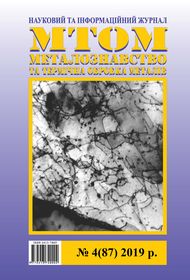Affect of temperatures on the porosity of nanoporous carbon derived from titanium carbide
DOI:
https://doi.org/10.30838/J.PMHTM.2413.241219.51.601Keywords:
nanoporous carbon, titanium carbide, high temperature chlorination, specific surface area, pore size distributionAbstract
Purpose. The research was aimed to determine the dependence of the specific surface area and pore size distribution on the synthesis temperature for nanoporous carbon obtained from titanium carbide by chlorine treatment. Methodology. Nanoporous carbon has been obtained by treating titanium carbide powder with a stream of chlorine in a flow-type experimental setup at temperature range from 300°C to 1 200 °C. The specific surface area and pore size have been determined using automatic equipment (Quantachrome, USA) with computer control and data processing. To determine the specific surface, the Brunauer – Emmett – Teller (BET) method has been used. The porous structure of carbon, namely the pore volume and its size distribution, has been determined on the basis of the non-local density functional theory (NLDFT) using the software which is supplied with the device. Results. It has been experimentally established that change of chlorination temperature at titanium carbide processing effects on the pore size of the resulting carbon and allows controlling the same pore size in a narrow size range. With increasing temperature, the total pore volume and specific surface area increase as well and reach their maximum value at a synthesis temperature of 1 000 ° C (up to 1 442 m2/g according to BET), while the number of micropores decreases and mesoporosity increases. Scientific novelty. It has been found for the first time that due to a change in the temperature of titanium carbide chlorination it is possible to obtain nanoporous carbon with a controlled pore size up to 2 nm. Practical significance. The research results can be used for developing technology of supercapacitor production.References
Simon P. and Gogotsi Y. Capacitive energy storage in nanostructured carbon-electrolyte systems. Accounts of chemical research. 2012, vol. 46, no. 5, pp. 1094–1103.
Shurygina V. Razmery superkondensatorov men'she, moshchnost' vyshe [Supercapacitors sizes are smaller, power is higher]. Electronics : Science, Technology, Business, 2009, no. 7, pp. 11–20 (in Russion).
Ania C.O., Pernak J., Stefaniak F., Raymundo-Pinero E. and Beguin F. Solvent-free ionic liquids as in situ probes for assessing the effect of ion size on the performance of electrical double layer capacitors. Carbon, 2006, vol. 44, pp. 3113–3139.
Kim Y.T., Lee B.J., Suezaki H.,ChinoT. and Abe Y. Preparation and characterization of bamboo-based activated carbons as electrode materials for electri double layer capacitors. Carbon, 2006, vol. 44, pp. 581–616.
Guo Y., Qi J., Jiang Y.X., Yang S., Wang Z. and Xu H.U.A. Performance of electrical double layer capacitors with porous carbons derived from rice husk. Materials Chemistry & Physics, 2003, vol. 80, pp. 704–709.
Wu F.C., Tseng R.L., Hu C.C. and Wang C.C. Physical and electrochemical characterization of activated carbons prepared from firwoods for supercapaictors. J. Power Sources, 2004, vol. 138, pp. 351–359.
Kovalyuk, Z.D., Yurtsenko S.P. and Semenchuk I.І. Poristyy uglerodnyy material iz rastitel'nogo syr'ya kak polyarizuyushchiy komponent elektrodov superkondensatorov [Porous carbon material from plant raw materials as a polarizing component of electrodes of supercapacitors]. Zhurnal nano- i elektronnoy fiziki [Journal of Nano- and Electron Physics]. Vol 7, no. 2, 2015, pp. 12–17. (in Russian).
Endo M., Maeda T., Kim Y.J., Dresselhaus M.S., Ohta H., Inoue T., Hayashi T. and Nishimura Y. Morphology and organic edlc applications of chemically activated Ar-resin-based carbons. Carbon, 2002, vol. 40, pp. 2613–2626.
Yang K.L., Yiacoumi S. and Tsouris C. Electrosorption capacitance of nanostructured carbon aerogel obtained by cyclic voltammetry. J. Electroanal. Chem., 2003, vol. 540, pp. 159–167.
Adhyapak P.V., Maddanimath T. and Pethkar S. Application of electrochemically prepared carbon nanofibers in supercapacitors. J. Power Sources, 2002, vol. 109, pp. 105–110.
Huang C.H., Wu Y.P., Hu C.C. and Li Y. Textural and electrochemical characterization of porous carbon nanofibers as electrodes for supercapacitors. J. Power Sources, 2007, vol. 172, pp. 460–467.
Chen J.H., Li W.Z., Wang D.Z., Yang S.X., Wen J.G. and Ren Z.F. Electrochemical characterization of carbon nanotubes as electrode in electrochemical double-layer capacitors. Carbon, 2002, vol. 40, pp. 1193–1197.
Zhao X.Z.X., Sanchez B.M., Dobson P.J. and Grant P.S. The role of nanomaterials in redox-based supercapacitors for next generation energy storage devices. Nanoscale, 2011, vol. 3 (3), pp. 839–855.
Presser V., Heon M. and Gogotsi Yu. Carbide-Derived Carbons – From Porous Networks to Nanotubes and Graphene Adv. Funct. Mater. 2011, vol. 21, pp. 810–833.
Nikitin A. and Gogotsi Y. Nanostructured carbide derived carbon, in Encyclopedia of nanoscience and nanotechnology. American Scientific Publishers : Stevenson Ranch CA., 2003, pp. 553–574.
Simon P. and Gogotsi Y. Capacitive energy storage in nanostructured carbon-electrolyte systems. Accounts of chemical research. 2012, vol. 46, no. 5, pp. 1094–1103.
Gogotsi, Y., Nikitin A., Ye H., Zhou W., Fischer J.E., Yi B., Foley H.C. and Barsoum M.W. Nanoporous carbide-derived carbon with tunable pore size. Nat. Mater. 2003, vol. 2, pp. 591–594.
Kravchik A.E, Kukushkina Ju.A., Sokolov V.V. et al. Structure of nanoporous carbon produced from boron carbide. Carbon. 2006, vol. 44, pp. 3263–3268.
Gregg S. and Sing К. Adsorption, specific surface area, porosity. Moscow : World Publ., 1984, 145 p. (in Russian).
Downloads
Published
Issue
Section
License
Authors that are published in this journal agree to follow the conditions:
Authors reserve the right to the authorship of his work and cede the right to the journal of first publication of this work on conditions of the license under the Creative Commons Attribution License, which allows others to distribute it freely with the obligatory reference to the author of the original work and the first publication of the work in this journal.

